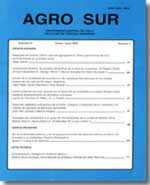Use of 137Cs in quantitative evaluation of soil erosión and sedimentation in a Palehuniult, located at the 9th Región
Main Article Content
Abstract
The 137Cs technique used for estimating mean soil redistribution rates is based on the uniform deposit of thiis anthropogenic radionuclide in a climatic zone and its quick adsorption by clay particles.
In order to evaluate the potential use of 137Cs technique in soils of South Chile, mean soil erosión and sedimentation rates and its spatial distribution were determined in a Palehumult of the 9th Región, based on tlie spatial distribution of the 137Cs inventory. For this purpose models were adapted to the 137Cs-deposition pattem, and soil and climatic conditions of the study área. The erosión/ sedimentation rates and their spatial distribution obtained by three different models were very similar. The highest erosión rates (10-30 t ha-1 y-1) were determined at the zones of maximal slope of the landscape, and the highest sedimentation (7-15 t ha-1 y-1) at footslope in water flow concentration sites. The results obtained has been validated by pedological observations and quantifícation of sediment flux in erosión plots. These results suggest that the 137Cs technique is a good altemative to determine soil redistribution rates under the soil and climatic conditions selected.

